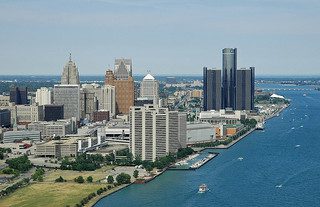
As someone who’s pretty deeply involved with Detroit, I’d been looking forward to seeing it. It turns out that it’s not really about that city at all. What Detropia’s filmmakers seem really to care about is what’s happened to manufacturing in this country, with the closing of factories and the loss of jobs. The message of the movie, if there is one, is that Detroit’s woes can all be attributed to that single, devastating, cause.
It’s not remotely true, of course. Yes, the closing of factories has been a devastating force all over the United States, and yes, it is certainly an important reason—although far from the only one—that so many of our older cities are in bad shape. But actually, Detroit still has a higher percentage of manufacturing jobs than almost any other major U.S. city: 7.9 percent of all the jobs in the city, compared to 6.9 percent in Cincinnati, 5.4 percent in Chicago, 4.4 percent in Baltimore, 3.9 percent in Philadelphia, and 2.7 percent in Pittsburgh, are in manufacturing.
There are a host of other very specific reasons why Detroit is losing population faster than any other large U.S. city, or why Detroit, rather than some other city, filed for bankruptcy. The problem with Detropia is that they don’t seem to be that interested in any of those reasons; to them, Detroit is the hook they use to make their case about what it means for the factories to close.
While it makes for a misleading movie, it still raises an important question that bears a closer look. The loss of manufacturing jobs has been a tragedy for the United States, and in particular for the cities that were the centers of our flagship industries, like Detroit or Pittsburgh. Those jobs, as many, many commentators have pointed out, not only provided the economic base for those cities, but enabled masses of American workers with limited formal education to attain middle-class status. I have no idea if we could have saved those companies, or kept them in those cities, but I don’t know that we tried very hard.
Now that people are heralding a manufacturing renaissance, though, does it mean that those jobs are coming back? Even if the renaissance is real, which many people doubt, the jobs are not coming back. Last week, the NY Times ran a piece on a cotton mill that recently reopened in South Carolina; the article points out that “the mill here produces 2.5 million pounds of yarn a week with about 140 workers. In 1980, that production level would have required more than 2,000 people.”
In Youngstown this spring I visited a state of the art new steel pipe mill that cost its French owners over $1 billion to build; at full production it will employ 350 people. The steel mills of the '60s and '70s often employed 25,000 to 30,000 people. Manufacturing will not bring back the good jobs we lost.
Whether the United States will continue to make things is one issue. Whether we will be a country where people without college degrees will be able realistically to aspire to something better than near-minimum wage jobs and near-poverty subsistence is another. In 1970, the average male worker without a high school diploma earned 57 percent of what a college graduate made. Today, his equivalent earns only 37 percent of what a college graduate makes. Meanwhile, not only do more jobs require college degrees, or other specialized education, but more and more employers are coming to require a college degree, even for jobs that historically were available to people without degrees. Nearly 40 percent of the jobs in Detroit are filled by people with college degrees, but only 12 percent of the adults in Detroit have such degrees.
This creates a devastating chain reaction not only in Detroit, but in many other cities. As more and more of the urban population, by virtue of limited education and specialized skills, are relegated to low-wage service and retail jobs, more and more of them are forced to commute to the suburbs, where those jobs are. With increasing poverty, neighborhood conditions deteriorate, and the lucky few who get well-paying manufacturing jobs as likely as not move to the suburbs. An important fact about Detroit, which you’d never be able to tell from Detropia, is that almost four out of every five people who work in the city’s remaining factories lives in the suburbs. Yes, Detroit has an economy, but it’s uncoupled itself from the city’s people.
Ultimately the challenge, in Detroit as elsewhere, is how to create an economy that can provide the kind of jobs and wages that will allow everyone who wants to work to find a job that can provide him or her with a decent living wage, to afford decent housing and raise a family. That’s the real issue, but maybe it’s too complicated to turn into a movie.





Comments